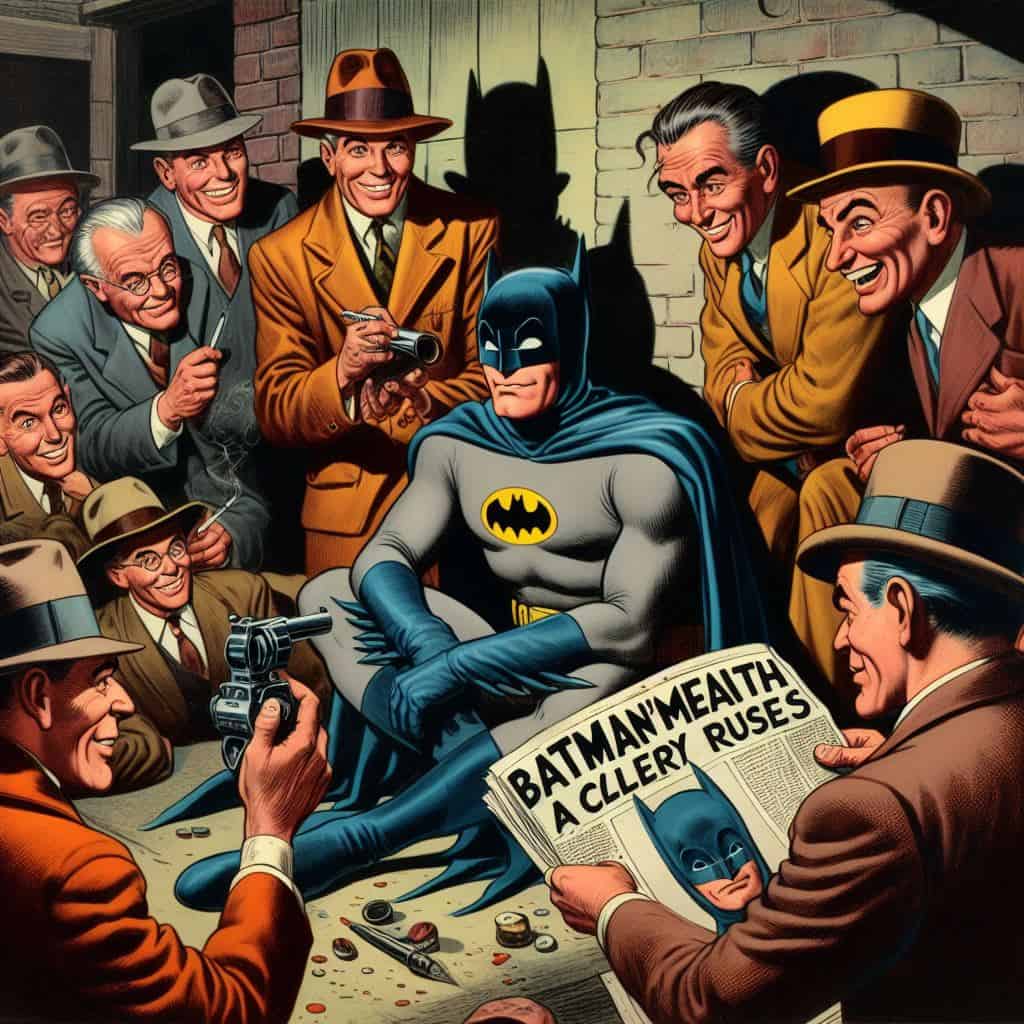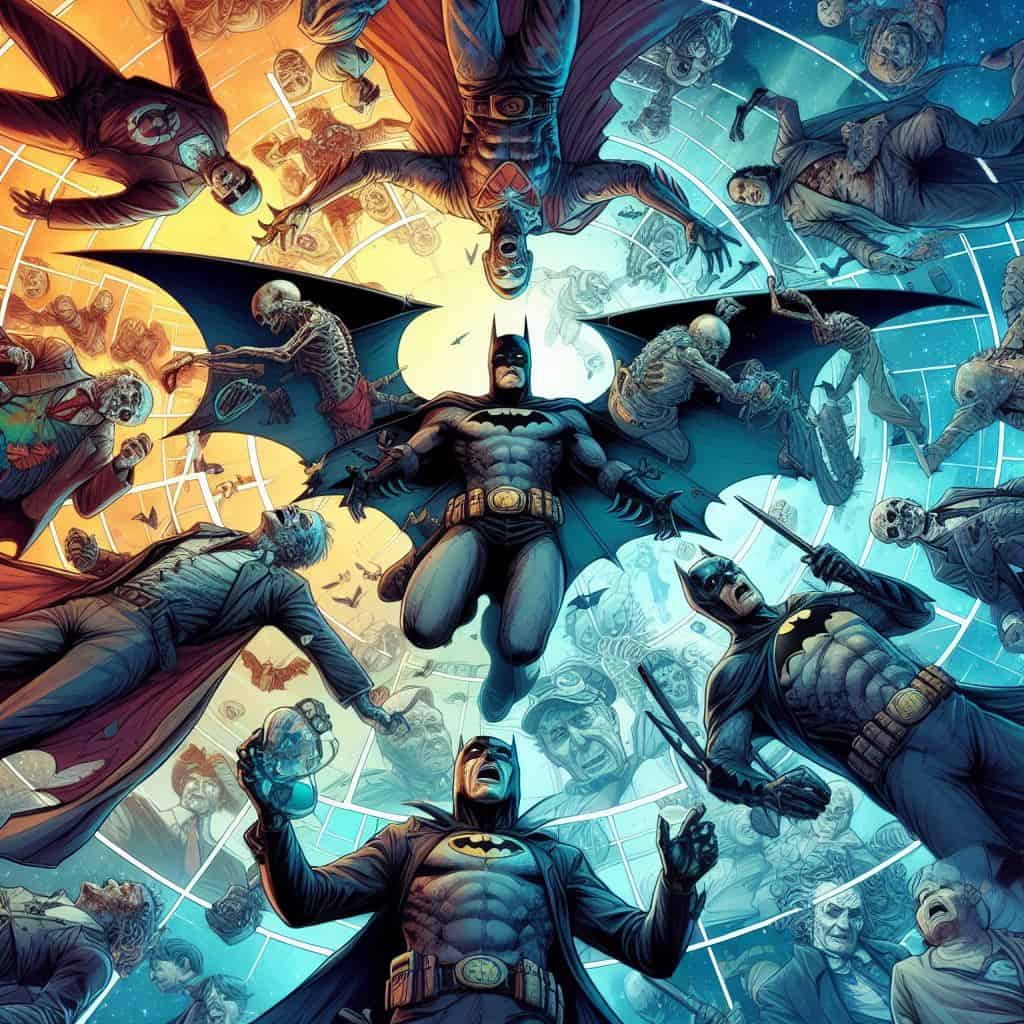The mortality of heroes is a central theme across literature and pop culture. In comic books, the concept of death takes on even greater meaning, with iconic characters meeting their end only to return again and again. This cycle of death and rebirth allows for rich storytelling opportunities.
Perhaps no character represents this heroic cycle more than Batman – the Dark Knight of Gotham City whose war against crime seems endless. His resilience and determination to protect others at all costs positions him as an enduring and legendary figure across DC Comics’ mythology. However, that dedication has often placed Batman in the face of mortal danger.
This article will examine the many instances that Batman has faced death by looking at early demises, confrontations with villains, heroic sacrifices, alternate realities, and the greater impact of his repeated deaths and rebirths on the timelines of DC Comics.
The Many Deaths of Batman: Exploring the Dark Knight’s Mortality
Batman’s mortality has been tested from his earliest adventures. His lack of inherent superpowers makes him vulnerable in his crusade against dangerous villains. Yet, this vulnerability only adds depth and nuance to his character. Batman transforms his own human limitations into powerful motivation to hone his detective skills, martial arts prowess, and strategic ingenuity in outwitting overwhelmingly lethal foes. His human qualities shine through his weaknesses, even as his uncanny ability to escape death builds his legend.
Batman’s escapes from death often require quick thinking, technical skill, and self-sacrifice for the greater good of Gotham City and the DC Universe at large. His moral code is unwavering, no matter the cost to himself. While Batman has certainly had close calls, his repeated resurrections affirm his heroism in choosing the noble path – dedicating himself fully to a perilous war against crime that he wages on behalf of society’s most vulnerable.
Batman’s First Death: A Clever Ruse in 1952

Batman’s first apparent death came quite early in his crimefighting career in the pages of Batman #72 in 1952. As part of an intricate infiltration plan, Batman feigned his own killing, leaving Robin to convey the ruse to support their larger goals of bringing down a crime syndicate preying on a small nation’s economy. The storyline showcased Batman’s ingenuity from his earliest days – using his apparent demise to his advantage as a clever tactic of subterfuge. This early confrontation with mortality demonstrated Batman’s resourcefulness and established key traits that would drive his continued war on crime for decades to come in DC Comics.
Electrifying Demises: Batman’s Confrontations with Electrical Villains

While strategic use of his apparent death served Batman’s ends early on, many later instances have shown true vulnerability to mortal wounds. His lack of inherent powers has frequently left him open to lethal ends when facing off with dangerous villains. Electrocution has posed one of the biggest risks to Batman’s safety as he regularly contends with electrically-charged villains. The 1985 Detective Comics #644 showed one such electrifying demise when battling the deranged Dr. Light, while an earlier The Brave and The Bold #115 depicted a fatal blast from an electrically-powered alien foe.
These electric deaths emphasize Batman’s human mortality against metahuman and enhanced villains. While his mortal fallibility could be seen as a weakness, it also showcases his relentless bravery to continue confronting intimidatingly lethal enemies to protect Gotham citizens. Willing to lay down his life against nearly any odds, Batman turns vulnerability into strength – both thematically in the messaging of the comics and diegetically within his own crusade against villainy.
Batman vs. Iconic Villains: Fatal Encounters

Batman’s mortality has perhaps been most tested in his many confrontations with his iconic rogues gallery of villains over the decades since his 1939 debut. These frequent foils know Batman’s human vulnerabilities intimately. Deathly encounters have resulted when Batman’s intelligence and skill have fallen short against homicidal masterminds like the Joker, Scarecrow, Poison Ivy, Two Face, and more.
For example, Legends of the Dark Knight #65 depicted one such fatal scheme when the Joker succeeded in manipulating events to lead to Batman’s death by a brutal bludgeoning. While Batman inevitably returns after even the most final-seeming endings, his occasional deaths at the hands of his most iconic villains carry symbolic meaning in showcasing the fine line Batman walks between life and fatality with every perilous mission into Gotham’s dark underworld. His human qualities may allow for mortal failings, but his perseverance to stare down death time after time cement him as a resilient hero defined by dedication in spite of lethal dangers from his most notorious villains.
Sacrifices for Greater Good: Batman’s Heroic Deaths

While many of Batman’s deaths result directly from attacks by villains, some of his most poignant ends have come from willful choices to sacrifice himself for the greater good. These heroic deaths demonstrate Batman’s commitment to justice and human wellbeing above all else, including his own survival. For example, the acclaimed Superman: Red Son series offered an alternate reality tale that ended with Batman choosing suicide as a tactic to destabilize Superman’s corrupted power, giving humanity a fighting chance at freedom.
Additionally, in the rebooted Earth 2 continuity, Batman gives his life distracting gruesome forces from attacking civilians. With this act, he saves millions of lives by paying the ultimate price. These selfless representations of sacrificial death choose the needs of the many over the drives of one man. They thematically reaffirm Batman’s heroism and valor in surrending his life willingly for the ideals he believes in when circumstances demand the highest cost.
Alternate Realities and Timelines: Diverse Deaths of Batman

The intricate world of DC Comics incorporates myriad alternative timelines and parallel worlds which have depicted Batman dying in diverse ways. Some lasts mere issues while others fundamentally reshape Batman legacy into new directions. The popular Flashpoint altered reality narrative crafted one of the most lasting impacts on the DC Universe by depicting Batman dying in a gritty, dystopian-tinged setting, giving way for his father Thomas Wayne to take up the vigilante mantle in his stead – resulting in vast ripple effects after DC Comics integrated elements of the Flashpoint universe in the subsequent New 52 continuity reboot.
Batman has died countless innovative deaths across DC’s ever-expanding media over decades of publication history, with each carrying narrative significance and reflection on the character. The Emperor Joker graphic novel offered another unique death scenario where Batman died and resurrected endlessly at the Joker’s chaos-driven whims in a philosophical exploration merging mortality and madness. No matter the world, timeline, or realm – Batman’s deaths reveal the interplay between sacrifice, duty, justice, and the weight of life and death decisions inhering at the core of Batman’s heroic ethos.
The Impact of Batman’s Deaths on the DC Universe

Batman holds an esteemed stature as a cornerstone of the DC Comics mythos. As such, his deaths – whether brief or impactfully lasting for extended narrative arcs – carry ramifications for fellow characters and storylines rippling across DC Comics eras. For example, Batman’s death in the Final Crisis Comic run served as a catalyst for successor Dick Grayson to adopt the cowl and fill his mentor’s absence for a time until Bruce Wayne’s eventual resurrection. This allowed for intriguing story potential exploring Batman’s legacy when others carry on his mission after his death.
Moments of Batman’s death uniquely leave space to analyze what his absence evokes in those around him. They offer windows into how loss of a legendary hero opens vacuums others feel compelled to fill while allowing reflection on the scope of Batman’s human impact. His mortality may crack the seeming invincibility of his intimidating cowled presence, but it strengthens his symbolic power by affirming that the ideas and hopes defining Batman ultimately transcend any one man underneath the cape and cowl, living on when one hero falls.
Batman’s Return from Death: The Cycle of Resurrection

Just as every demise carries significance for Batman and DC Comics at large, his narrative cannot permanently subsist without eventually rising from death back into Gotham’s dark alleyways. After mortal endings strike down Batman, continual resurrections restore him – affirming his storied history while allowing bold new creative directions as writers integrate innovations from his temporary absence into current lore.
Often mystical deus ex machina tropes facilitate the means of his returns – from supernatural interventions by forces like Wonder Woman’s ally, the Greek gods, who resurrected Batman after his Emperor Joker demise, to cosmic machinations by reality-warping entities like Mr. Mxyzptlk who allowed for Batman’s revival after the Emperor Penguin ended his life in the Batman #300 milestone issue. Other returns have relied on more grounded explanations such as Batman sleight-of-hand tricks making his death mere illusion to even advanced Lazarus Pit restorative techniques resurrecting Bruce Wayne after suffering fatal wounds.
No matter the precise method behind Batman’s perpetual return from mortal endings, his cyclical death and rebirth serves dual purposes – allowing impactful consequences of his absence for other characters while also affirming his iconic presence inevitably rebounds to once more take up his timeless crusade to uphold justice against Gothic Gotham’s endless tide of crime and corruption. His constant confrontations with mortality only serve to intensify the indomitable willpower and commitment symbolizing Batman’s legend.
Conclusion
Batman’s has provided intriguing opportunities to explore death and heroism over the Dark Knight’s eight decades as a pop culture icon. His lack of superhuman powers leaves him constantly vulnerable, yet willing to adopt any risk in his war against the forces preying on society’s most vulnerable citizens. This human dimension makes his struggle relatable. His uncompromising conscience drives him past fears of death and defeat that could halt more self-interested figures. And his uncanny ability to escape lethal threats builds mystery around a figure seeming to twist reality to his willpower-fueled crusade.
From early fake-out deaths to fully realized sacrifice, Batman’s multilayered confrontations with mortality showcase a heroic ethos valuing justice over any individual life. His human qualities ground his quest while functionally immortal ideas of conscientious heroism endure continually reviving Batman to stalk Gotham’s grim alleyways and ever-present evils once more as stories demand his return.
Perhaps above all, Batman’s cycles of death and rebirth place him as a layered folk figure and modern myth who cannot perish even as he boldly courts the dangers that fell less determined heroes. Behind the mask, Batman remains driven by conviction to stand against the tide of criminality – forever punching back against death towards righteous ends protecting the innocent no matter the odds. Through bold imagination of Batman’s mortality across domains of creative expression, audiences share vicariously in facing our fears of death to uphold moral courage – distilled iconically through decades of DC Comics’ Dark Knight detective stories unveiling the unending war for justice Batman wages against oblivion itself.



Leave a Reply